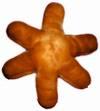French Recipe
La Fouace Nantaise »
This delicious sweet bread type was conceived in the 19th century by the local grape wine grower of la Haye-Fouassière, a small country town located only 20 miles away from my home town Nantes. It is shaped like a six branch star. This is a rather filling bread made of flower, leaven and cold sweet sirup. It is enriched with butter and sugar.
This is a treat that my grand-mother made and I loved it. It was delicious with a cup of tea with milk as an afternoon snack. I remember eating it at my grand mothers while watching black&white television with my cousins. It is also the customary to eat Fouace at the wedding toast. Although I was too young to have a drink at many of my aunts and uncles weddings, I used to grab as many pieces of Fouace as I could! Adults will eat it with a glass of Muscadet (local white wine).
Here is the receipe for la fouace nantaise :
5 people ; préparation : 15 minutes ; Time of rest for the dough : 10h ; cooking time : 20 minutes
What you need :
· 500 g of wheat flower
· 100 g of butter
· 15 g of yeast
· 4 eggs
· 1 small glass of brandy
· 10 cl of milk
· Eau de fleur d’oranger
· vegetable oil
In a pot, prepare and mix the wheat flour with all the ingredients (the soft butter, the yeast, the three eggs, the glass of brandy, the milk and few water drop of orange tree flower). Let the dough rest for the hours.
Shape the dough in a crown or six branch star shape on a lightly oiled wax paper and let it cook for twenty minutes at medium heat in an oven (thermostat 6).
Collectors Analysis: This dish is a classic item from Nantes, and as a kid myself I grew up eating it even in the United States. Because the metric system is not used in the United States, using the American system actually changes the taste of the dish somewhat. In addition, the bread in France rises differently, preventing the Fouace Ive tasted in the United States from being similar from the ones in France.
Annotation: “The Country Cooking of France” by Anne Willan

